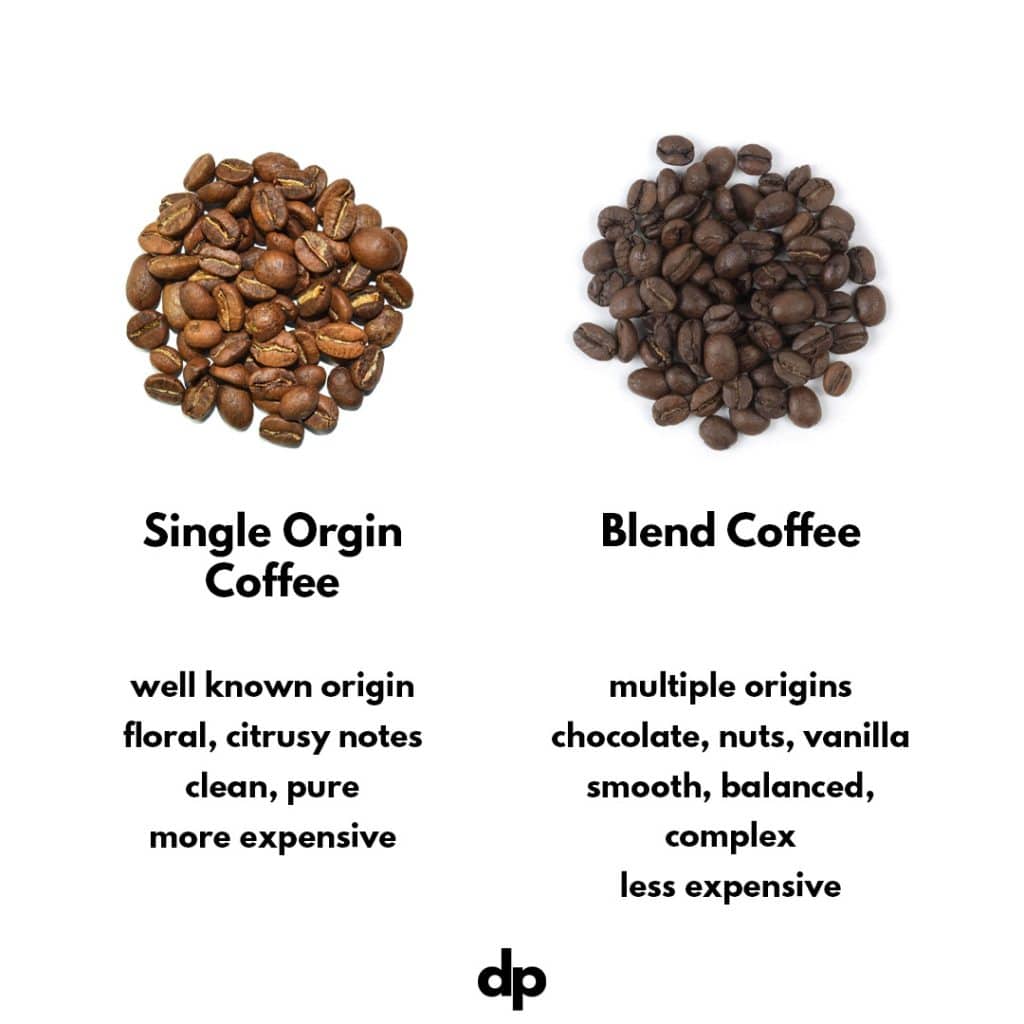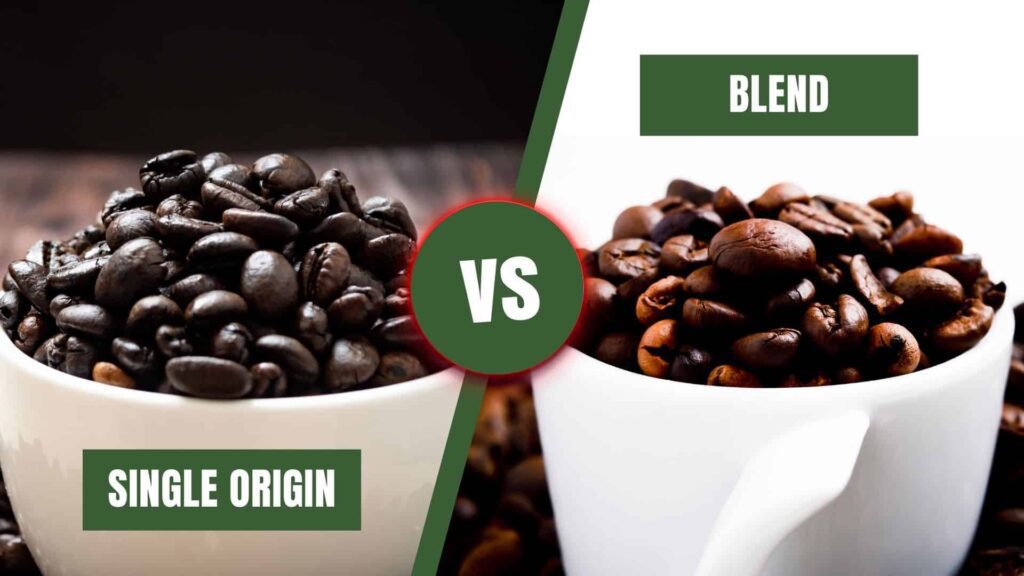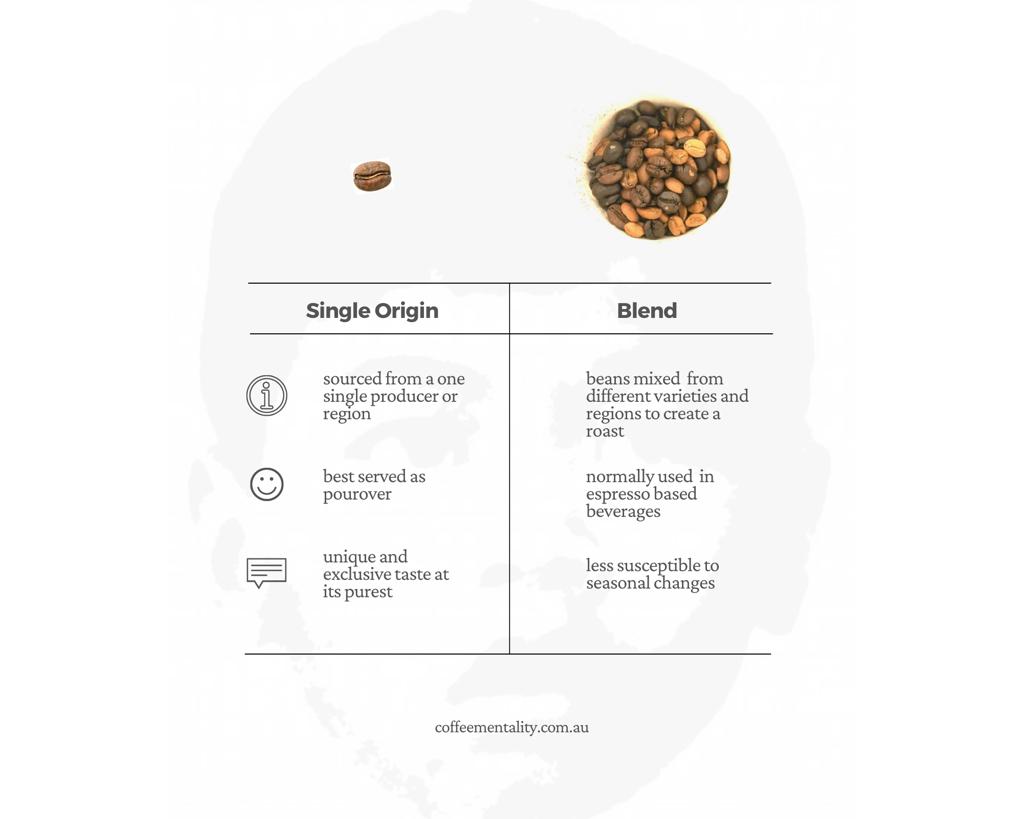If you’ve ever wondered about the differences between coffee blends and single-origin coffees, you’ve come to the right place.
In this article, we’ll explore what constitutes a coffee blend and how it differentiates itself from a single-origin coffee.
Whether you’re a coffee aficionado or simply interested in expanding your Java knowledge, this article will demystify the world of coffee blends and help you appreciate the unique characteristics they bring to your cup.
So grab your favorite mug and get ready to embark on a caffeinated journey!
Definition of Coffee Blend
Blend of Different Coffees
A coffee blend refers to a combination of different types of coffee beans. It involves blending together beans from various regions, sometimes even different countries, to create a unique flavor profile. These beans may vary in origin, roast level, and characteristics.
Blending Process
The blending process involves carefully selecting beans with complementary flavors and characteristics. Coffee roasters experiment with different combinations of beans to achieve the desired taste and aroma. The beans are often roasted separately before being blended to enhance their characteristics. Blending requires expertise and precision to create a harmonious and balanced final product.
Flavor Profile
One of the primary reasons for creating a coffee blend is to achieve a specific flavor profile. By combining different beans, roasters can create a well-rounded and complex flavor experience. Blends can possess a wide range of flavor notes, from fruity and vibrant to chocolatey and nutty. The goal is to create a balanced and enjoyable cup of coffee that appeals to a wide range of palates.
Characteristics of Single-Origin Coffee
Definition and Origins
Single-origin coffee refers to coffee beans sourced from a specific geographic region or even a single farm. These beans are not blended with others and are meant to showcase the unique characteristics of their specific origin. Each single origin coffee has its distinct flavor profile, influenced by factors such as soil composition, climate, and cultivation practices.
Distinct Flavor Profile
One of the defining features of single origin coffee is its distinct flavor profile. These coffees offer an opportunity to explore a particular region’s nuanced and unique tastes. For example, an Ethiopian coffee might exhibit floral and fruity notes, while a Colombian coffee could have a chocolatey and caramel-like flavor. This diversity allows coffee enthusiasts to appreciate the individuality of different origins.
Tracing the Origins
Another notable aspect of single-origin coffee is the ability to trace its origins. With single origin beans, you have the opportunity to learn about the specific coffee farm, the local farmers, and the way the beans are cultivated. This transparency can provide a sense of connection and appreciation for the coffee beans’ journey before reaching your cup.
Differences Between Coffee Blend and Single Origin Coffee
Composition
The primary distinction between coffee blends and single origin coffees lies in their composition. Coffee blends consist of a combination of beans from various regions, while single origin coffee is sourced from a specific geographic location or farm. Blends offer the opportunity to create unique flavor profiles that cannot be replicated by single-origin coffees alone.
Consistency
Coffee blends are known for their consistency in taste. Roasters can maintain a consistent flavor profile throughout the year by combining different beans. On the other hand, single-origin coffees may vary in taste due to factors such as seasonal variations, changes in crop yield, or differences in farming practices. This variation can be seen as a positive aspect, highlighting the ever-changing nature of the coffee industry.
Flavor Complexity
While both coffee blends and single origin coffees can exhibit a wide range of flavors, blends often offer a more complex taste experience. The combination of beans allows for a harmonious blend of different flavor notes, resulting in a more layered and multifaceted profile. On the other hand, single-origin coffees may offer more distinct and focused flavor profiles that showcase the unique attributes of their specific origin.
Advantages of Coffee Blend
Consistency in Taste
One of the main advantages of coffee blends is the consistency they provide in terms of taste. Blends are carefully crafted to maintain a specific flavor profile throughout the year. This means that regardless of when you purchase a bag of your favorite blend, you can expect a consistent taste experience. This reliability can be especially appealing for those who have preferred a particular blend.
Avoiding Seasonal Variations
Coffee blends are often designed to mitigate the effects of seasonal variations. The availability and quality of single-origin coffees can fluctuate due to changes in climate, rainfall patterns, and other agricultural factors. By creating blends that incorporate beans from various regions, roasters can minimize the impact of these variations. This ensures a reliable supply of coffee that is not dependent on the seasonality of specific origins.
Balanced Flavor Profiles
Blending different beans allows for the creation of balanced flavor profiles. The combination of beans with varying characteristics and flavor notes can result in a more well-rounded and enjoyable cup of coffee. Blends often aim to strike a balance between acidity, sweetness, body, and other flavor elements. This balance appeals to a wide range of palates and provides a consistent yet diverse coffee drinking experience.
Advantages of Single-Origin Coffee
Unique Tastes and Aromas
Single-origin coffees offer the opportunity to explore and appreciate different regions’ unique tastes and aromas. Each origin has its distinct flavor profile that reflects the specific environmental conditions and farming practices. From the vibrant fruity notes of African coffees to the rich chocolaty undertones of Central and South American coffees, single-origin beans provide diverse taste experiences.
Supporting Small Farms
When you purchase single-origin coffee, you often directly support small-scale farmers. Single-origin beans are often sourced from specific farms or cooperatives, where the focus is on quality and sustainable practices. By opting for single-origin coffee, you contribute to the livelihoods of these farmers and help sustain their businesses. This direct relationship fosters a sense of community and allows you to impact the coffee-growing regions positively.
Tracing Ethical Sourcing
Single origin coffees provide an opportunity to trace the journey of the beans from farm to cup. Many roasters emphasize transparency and ethical sourcing practices when it comes to single origin coffee. By understanding the origins of the beans, you can ensure that your coffee is sourced responsibly, with fair prices paid to farmers and sustainable production methods employed. This knowledge enhances the overall coffee experience and allows you to make informed choices as a consumer.
Popular Types of Coffee Blends
Espresso Blends
Espresso blends are crafted explicitly for espresso-based beverages, such as lattes, cappuccinos, and espressos. These blends are designed to achieve a balance between the bold flavor and velvety texture required for espresso. They often feature a combination of beans with a rich and full-bodied flavor profile, capable of cutting through the milk in milk-based drinks or standing on their own as a shot of espresso.
Breakfast Blends
Breakfast blends are known for their smooth and mellow flavor profiles. These blends are typically medium or light roasted, offering a balanced level of acidity and brightness. Breakfast blends aim to provide a clean and refreshing start to the day without overwhelming the senses. They can be enjoyed with or without milk, depending on personal preference.
Signature Blends
Signature blends are unique creations by coffee roasters, often representing their specific style and expertise. These blends are carefully crafted to showcase the roaster’s skill in combining different beans to create a distinctive flavor profile.
Signature blends can offer various flavor characteristics, catering to different preferences and taste preferences. They often reflect the roaster’s artistry and passion for coffee.
Exploring Single Origin Coffees
Central and South American Coffees
Central and South American coffees are known for their smooth and well-balanced flavor profiles. Countries like Colombia, Brazil, and Costa Rica produce beans often characterized by their medium body, mild acidity, and nutty or chocolaty undertones. These coffees are versatile, suitable for various brewing methods, and offer a reliable and consistent taste experience.
African Coffees
African coffees are renowned for their vibrant and complex flavor profiles. Countries such as Ethiopia, Kenya, and Tanzania produce beans with fruity, floral, and sometimes even wine-like notes. African coffees are often prized for their acidity, brightness, and unique flavor characteristics. They offer an exciting and dynamic taste experience that can be especially intriguing for coffee connoisseurs.
Asian Coffees
Asian coffees, particularly those from Indonesia and Vietnam, offer distinct taste profiles that differ from their African and South American counterparts. Indonesian coffees, such as those from Sumatra, are known for their whole body, low acidity, and earthy and herbal flavors. Vietnamese coffees, often prepared using a traditional drip filter called a “phin,” have a strong and bold flavor profile with hints of chocolate and spice. Asian coffees provide a rich and diverse range of taste experiences.
Factors to Consider When Choosing a Coffee
Preference for Consistency or Variety
Consider whether you prioritize consistency in taste or if you enjoy exploring different flavor profiles. Coffee blends offer a consistent taste experience throughout the year, while single-origin coffees may vary in flavor due to seasonal and farming factors. Determine whether you prefer the reliability of a familiar taste or the excitement of discovering new flavors.
Desired Flavor Profile
Think about the flavor characteristics you enjoy in a cup of coffee. If you prefer a well-rounded and balanced taste experience, a coffee blend may be the right choice for you. On the other hand, if you appreciate the unique and distinct flavors associated with specific origins, single origin coffees offer a more comprehensive range of flavor profiles to explore.
Ethical and Sustainable Sourcing
Consider your values and the sourcing practices that align with them. If supporting small-scale farmers and knowing your coffee’s origin is essential, single-origin coffee directly connects to the source. Look for certifications like Fair Trade or Rainforest Alliance to ensure your coffee is sourced ethically and sustainably.
Brewing Tips for Coffee Blends
Grind Size and Extraction
The grind size is crucial in extracting the desired flavors from your coffee blend. For most brewing methods, a medium grind is recommended as it balances extraction and clarity of flavor. However, adjusting the grind size to suit your brewing equipment and personal taste preferences is essential. Experimentation is vital to finding the ideal grind size for your preferred brewing method.
Brewing Methods
Coffee blends can be brewed using various methods, such as pour-over, French press, or espresso. Each brewing method highlights different aspects of the blend’s flavor profile. For example, a pour-over method may emphasize brightness and acidity, while a French press can enhance the body and richness. Choose a brewing method that best suits your taste preferences and showcases the desired flavor characteristics of the blend.
Experimenting with Ratios
Explore different ratios of coffee to water to tailor the strength and intensity of your brew. Start with a recommended ratio and adjust it based on your personal taste preference. This experimentation allows you to fine-tune your brewing process to achieve the ideal balance of flavor and strength. Remember to keep note of your preferred ratios for future reference.
Brewing Tips for Single-Origin Coffees
Finding Optimal Extraction
Since single origin coffees have distinct flavor profiles, it’s essential to focus on extracting the specific flavors unique to each origin. Adjust the grind size, water temperature, and brewing time to achieve optimal extraction. Fine-tuning these variables can help highlight the nuanced flavors of the single origin coffee and bring out its full potential.
Highlighting Unique Flavor Notes
To fully appreciate the unique flavor notes of single-origin coffees, consider using brewing methods that allow for clarity and precision.
Methods such as the pour-over or AeroPress can accentuate the individual characteristics of the beans. Try to savor the coffee without milk or additional flavorings to fully experience the distinct flavors and aromas.
Adapting Brewing Techniques
Different single origin coffees may require adjustments in brewing techniques to bring out their best qualities. For example, African coffees with bright acidity may benefit from a slightly higher water temperature to enhance their complexity.
Similarly, Indonesian coffees with low acidity and whole body may require a coarser grind size to prevent over-extraction. Pay attention to the specific characteristics of the coffee and adjust your brewing techniques accordingly.
In conclusion, understanding the difference between coffee blends and single origin coffees can help you make more informed choices when selecting your next cup of joe. Coffee blends offer consistency, balanced flavor profiles, and the ability to avoid seasonal variations.
On the other hand, single-origin coffees provide unique tastes and aromas, support small farms, and allow for a deeper understanding of ethical sourcing. Whether you prefer the familiarity of a reliable blend or the exploration of distinct origins, a vast world of coffee is waiting to be discovered. So go ahead, brew a cup, and savor the richness and diversity of the coffee experience!









































